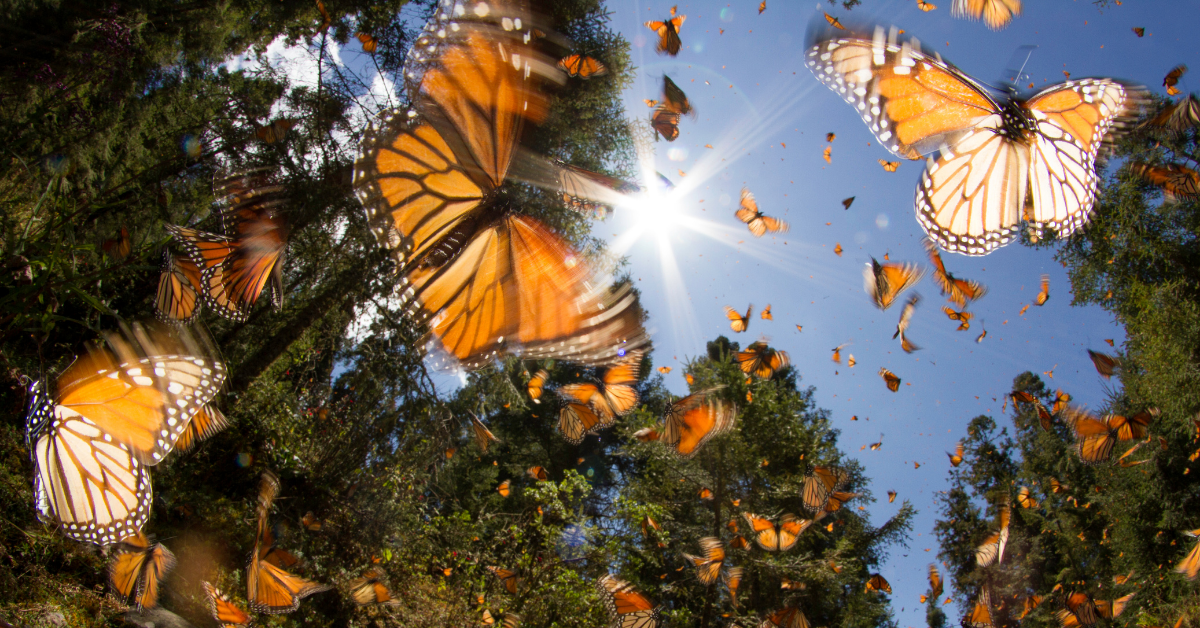The Mystery of The Monarch Butterfly
The great monarch butterfly may be the most loved and talked about butterfly to ever flutter across the earth. They’re the only insect that’s known to migrate such a long, intercontinental distance.
Each year, they migrate to overwintering sites in Mexico, down along the San Andres Mountain range, and along the coast of California.
Then, each spring the monarch butterflies return back to the many breeding areas and the cycle repeats itself, just like it has for millennia.
Monarch butterflies follow their migration pattern by way of the sun. It’s based on the horizontal position of the sun, and the time of day, this gives the butterflies an internal compass for traveling this mighty journey.
This is one of nature’s most spectacular, natural phenomena ever known to exist.
However, this cycle and the miracle of the monarch migration is on the brink of disappearing forever.
But, there’s still hope in protecting these delicate lifeforms if we choose to, read on to learn more.
Wanna help save monarch butterflies? Plant milkweed seeds and help save them now!
Threats To The Monarch Butterfly
Researchers and scientists have been trying to determine what the cause(s) of their decline are, some of the potential theories include:
-
Habitat loss that’s due to land development, human expansion, and negative land care and management with very little stewardship. The primary plant that the monarchs use for habitat is the milkweed floweing plant that’s needed for the cute baby caterpillars to grow from larvae and transfrom into a magnificent butterfly.
-
Drought and climate change
-
The widespread and unchecked us of lawn chemicals, pesticides, herbicides, neo-incecticides which have detrimental effects on monarchs and other invertebrate insects that are all essential for life on earth to flourish and continue.
-
Industrial chemicals and byproducts.
-
Automobile windshields.
Below is a short documentary on the monarch butterfly migration.
How You Can Help Monarchs
- First, Plant milkweed seed, lot’s of it! Monarch caterpillars require the milkweed plant in order to grow and develop properly. Keep in mind that there are over 100 varieties of milkweed, but the good news is the common milkweed species is kind of like a universal variety that can be planted just about anywhere and is good for the monarchs.
- Get free milkweed to plant here.
- Check out the “Bring Back The Monarch Campaign at www.monarchwatch.org to learn more about the best type of milkweed to plant in your region.
- Secondly, monarch’s need a steady supply of butterfly nectar plants, once they fly away from the milkweed host plant. There’s a multitude of floweing nectar plants that can thrive in your garden, plus they’re pretty to look at to, especially when the monarchs are dancing around them!
- Download the FREE Monarch Plant List in PDF format here.
- Next, use your voice and speak up. Encourage governmens and local and regional land managers to plan with monarchs and other essential insects and pollinators in mind. From parks, to roadside areas and many other public right of ways are all good places to encourage butterfly habitat.
- And, if that doesent work, then utilze guerilla gardening just make seed bombs and plant anyways.
We’re at a point in time where it’s to late to sit on the side lines and wait for governments to make up theri minds and approve projects and simple plantings, never forget species are dying and on the brink of extintion.
Support your local land conservancy and encourage people everywhere to preserve and protect their land.
Spread the Homegrown National Park revolution, because “In the past, we have asked one thing of our gardens: that they be pretty. Now they have to support life, sequester carbon, feed pollinators and manage water.” — DOUG TALLAMY
Support monarch conservation efforts. There are many different conservation initiatives happening in different parts of the country, and in other countries, consider volunteering or donation, or sharing on social media!
Avoid using pesticides, and help educate people on the DANGERS of using pesticides and other chemicals in their gardens.
Consider donating to environmental nonprofits that are working to protect and educate people about the importance protecting bees, butterflies, pollinators and other flying insects.
Learn more about butterfly nonprofits here.
Monarch Quick Facts



Monarch Fact Sheet Credit From The North American Monarch Conservation Plan
Habitat Restoration and Management Live Webinar Series
This is a comprehensive 5-part symposium style workshops that helps guide and educate land and property owners on how to properly and effectivel restore and manage land with monarchs in mind. Very informative.
MONARCH BIOLOGY AND ECOLOGY (30 MIN)
MONARCH & NATIVE POLLINATOR HABITAT DESIGN
MONARCH AND NATIVE POLLINATOR HABITAT MANAGEMENT
PROJECT IMPLEMENTATION AND MANAGEMENT
Monarch Resources
Monarch Garden Plants (Big list of about 20 different plants or so).
https://www.pollinator.org/pollinator.org/assets/generalFiles/MonarchGardenPlants_170625_152424.pdf
https://monarchjointventure.org/monarch-biology
https://www.pollinator.org/monarch
https://www.fws.gov/savethemonarch/
https://www.saveourmonarchs.org/
North American Monarch Conservation Plan
https://www.fs.fed.us/wildflowers/pollinators/Monarch_Butterfly/conservation/conservation_plan.shtml
Monarch Butterfly Poster (Print it and post it).
More monarch resources
The Monarch Larva Monitoring Project | Citizen Scientists Monitor Monarch Butterflies

